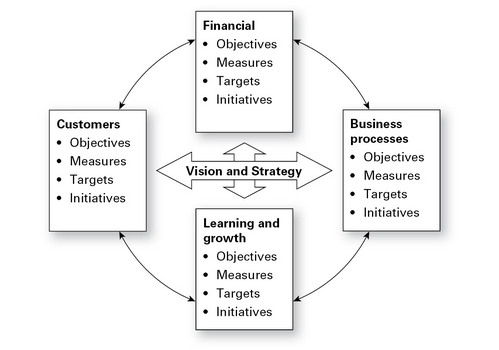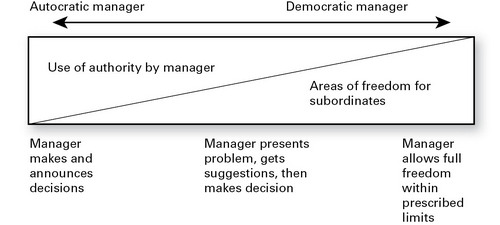The 30 Day MBA (30 page)
Authors: Colin Barrow

Your position on the grid is arrived at by answering a battery of questions that can be obtained from
www.leadership-and-motivation-training.com/support-files/blake-mouton-questionnaire.pdf
.
Management by objectives
Peter Drucker first described this system in his book,
The Practice of Management
(1954). Drucker's proposition was that managers should sidestep what he called the âactivity trap' where managers got involved in the minutiae of day-to-day activities and set them SMART objectives:
- Specific â relate to specific tasks and activities, not general statements about improvements.
- Measurable â it should be possible to assess whether or not they have been achieved.
- Attainable â it should be possible for the employee to achieve the desired outcome.
- Realistic â within the employee's current or planned-for capability.
- Timed â to be achieved by a specific date.
Objectives, Drucker claimed, should cascade throughout the organization, interlocking so that the overall business objectives would be achieved.
Value-based management
The value-based management (VBM) model is the management approach that goes a stage beyond objectives and introduces the idea that organizations are run consistently for long-term shareholder value. That doesn't mean ignoring other stakeholder groups. The three guiding principles of VBM are:
- Creating value: actively seeking ways to increase or generate maximum long-term value.
- Managing for value: colleagues, customers, community and shareholders.
- Measuring value: validating that long-term real value has been created by using appropriate financial techniques such as discounted cash flow (see
Chapter 2
, âInvestment decisions').
Balanced scorecard
The balanced scorecard (
Figure 4.9
), developed by Robert Kaplan and David Norton and published in a
Harvard Business Review
article in 1992, is a management process that sets out to align business activities to the vision and strategy of the organization, improve internal and external communications, and monitor organization performance against strategic goals. Its uniqueness was to add non-financial performance measures to traditional financial targets to give managers and directors a more âbalanced' view of organizational performance. Although Kaplan and Norton are credited with coining the phrase, the idea of a balanced scorecard originated with General Electric's work on performance measurement reporting in the 1950s and the work of French process engineers (who created the
Tableau de Bord
â literally, a âdashboard' of performance measures) in the early part of the 20th century.
FIGURE 4.9
 Â
The balanced scorecard

Four perspectives are included in the management process, which in effect extends the range of management by objectives and value-based management into areas beyond purely financial target setting. A number of objectives, measures, targets and initiatives can be set to achieve specific key performance indicators (KPIs) for each perspective in terms of:
- Financial: These include KPIs for return on investment, cash flow, profit margins and shareholder value.
- Customer: Here the KPIs can be for customer retention rates, satisfaction levels, referrals and complaints.
- Internal business processes: These can include stock turn, accident rates, defects in production, reduction in the number of processes and improvements in communications.
- Learning and growth: Employee turnover, morale levels, training and development achievements and internal promotions vs new recruits are all KPIs to use here.
The four perspectives are linked by a double feedback loop whose purpose is to ensure that KPIs are not in conflict with one another. For example, if customer satisfaction could be achieved by improving delivery times, achieving that by, say, increasing stock levels might conflict with a financial target of improving return on capital employed. (See
Chapter 1
for a refresher on financial ratios.)
Delegation: the essential management skill
To be effective an MBA needs to acquire for themselves and engender in their own management team the ability to delegate, also known as the art of getting things done your way by people who are happy to do so. Delegation is the tool that frees up your time for higher tasks â strategic planning, for example. Also, no organization can grow, and from a career perspective no MBA can move up, until someone else is in place to fill their role; delegation is a key tool in developing staff to be ready to take on more responsibility. Done effectively, delegation is also highly motivating. Look back to both the Hawthorne experiment and Hertzberg's hygiene factors described earlier in this chapter to remind yourself why.
The theoretical framework MBAs are most likely to come across that gives guidance on delegation is that espoused by R Tannenbaum and W H Schmidt, published in the
Harvard Business Review
in May/June 1973, in an article entitled âHow to choose a leadership pattern' (
Figure 4.10
). The thinking behind their ideas was to give managers a way to see how to choose the most appropriate managerial style or use of authority, ranging from boss-centred (task) to subordinate-centred (relationship) dependent on their and their team's capacity for delegation. For example, a manager with weak communication skills, leading an untrained team in an organization with poor or inadequate control systems, will not be able to move far along the continuum.
FIGURE
4.10
 Â
The leadership continuum â Tannebaum, Schmidt

Eight steps to successful delegation
Delegation is difficult and most people experience a loss of control or a fear that the people they are delegating to are not really capable of doing the task
well. These natural fears and concerns have to be understood and managed if delegation is to succeed. These eight steps improve the prospects for success in delegation:
- Decide what tasks to delegate and, equally importantly, what not to: Routine jobs can usually be passed on with little difficulty but other areas may involve training people up. Confidential or disciplinary work, tasks with strategic or legal and regulatory implications, are not likely candidates.
- Don't just select unpopular and tedious tasks to dump on others. Pass on worthwhile work that will genuinely widen experience and skills.
- Choose who to delegate to: Ideally someone with the right skill set, who is not already overloaded and who is likely to stay around long enough for the organization to gain from the experience too.
- Discuss the changes with the person concerned, get their commitment and then let everyone in the relevant part of the organization know about the change in role and why.
- The subordinate concerned must be given the authority to do the job and to make independent decisions.
- Follow up soon and review frequently to make sure the tasks delegated are being done satisfactorily and that no other work is suffering.
- Reward appropriately for a successful delegation.
- Communicate the success to the team to reinforce the value of taking on additional responsibilities, personal development and the opportunities for career progression.
If the structure is the skeleton and people are the blood and guts, systems are the rules and procedures that enable an organization to function effectively and to prepare itself for the changes ahead.
Rewards
While money is more a hygiene factor than a motivator, people come to work to get paid and if they achieve great results they expect great rewards. There is no single aspect of an employee's life more susceptible to gripes and complaints than pay. So how can you make sure that doesn't happen in your organization?
- First, make sure you are paying at least the going rate for the job in the area. Don't think you are getting a bargain if you get an employee to work for less than that figure; if they do, either they are not good at their job, a poor time keeper or have some other disability that you will find out about later; or they are good and when they find out they will feel cheated and leave. The easiest way to find the going rate is to look at advertisements for similar jobs in your area or visit PayScale (
www.payscale.com
> EMPLOYERS) where you can get accurate real-time information on pay scales. - Include an element of incentive for achieving measurable goals. This could be commission, perhaps the easiest reward system, but it really only works for those directly involved in selling. Or a bonus for successful performance, usually paid in a lump sum related as closely as possible to the results obtained. The Chartered Institute of Personnel and Development (
www.cipd.co.uk
) gives further guidance on a comprehensive range of reward options. - Benefits in kind are a form of compensation that is not part of basic pay and that isn't tied directly to their performance. Pension, working conditions, being allowed to wear casual dress, on-site childcare, personal development training, company product discounts, flexible hours, telecommuting and fitness facilities are all on the list of benefits that are on offer in certain jobs today. There may be tax implications on benefits in kind.
- Team awards can be used to engender better teamwork. Where money is involved it should be spent on things of value to the team. It could be an evening out, or any other social event. It could also be used to buy a business asset that's nice to have but could not really be justified on business grounds, for example a dedicated photocopier.
Appraisals
An appraisal is almost certainly an MBA's first point of contact with an organization's systems and the most likely one to cause dissatisfaction and frustration. Although supposedly not about blame, reward or even praise, that's how it ends up. Its output is a personal development plan to help everyone perform better and be able to achieve career goals.
There are plenty of standard appraisal systems and procedures; many are little more than a tick boxes and rating process; others are built around buzzwords such as â360 degree appraisals', meaning that staff below and above as well as peers have an input into the process.
There are really only four ground rules for successful appraisals:
- The appraisal needs to be seen as an open two-way discussion between people who work together, rather than simply a boss/
subordinate relationship, and prepared for in advance. Discussion should be focused on achievements, areas for improvement, overall performance, training and development, and career expectations and not salary (that's for a separate occasion). - It should be results oriented rather than personality oriented. The appraisal interview starts with a review against objectives and finishes by setting objectives for the next period.
- Appraisals should be regular and timely. At least annually, perhaps more frequent in periods of rapid change. New employees should be appraised in their first three months.
- Sufficient time should be allowed and the appraisal needs to be carried out free from interruptions.
The DEVA Workforce Development Toolkit developed by the Learning + Skills Council County Durham (
www.workforcedevelopment.org.uk
) aims to help employers create a realistic and effective, action-based training plan â getting the best out of training investment, for both appraiser and appraisee.
Development
If an organization is only as effective as the people it employs, it follows that the money invested in developing them and improving their skills should translate into improved results for the business as a whole. The statistics support the argument that money spent wisely on development pays dividends, so as a task it forms a major part of the human resources department's workload.
